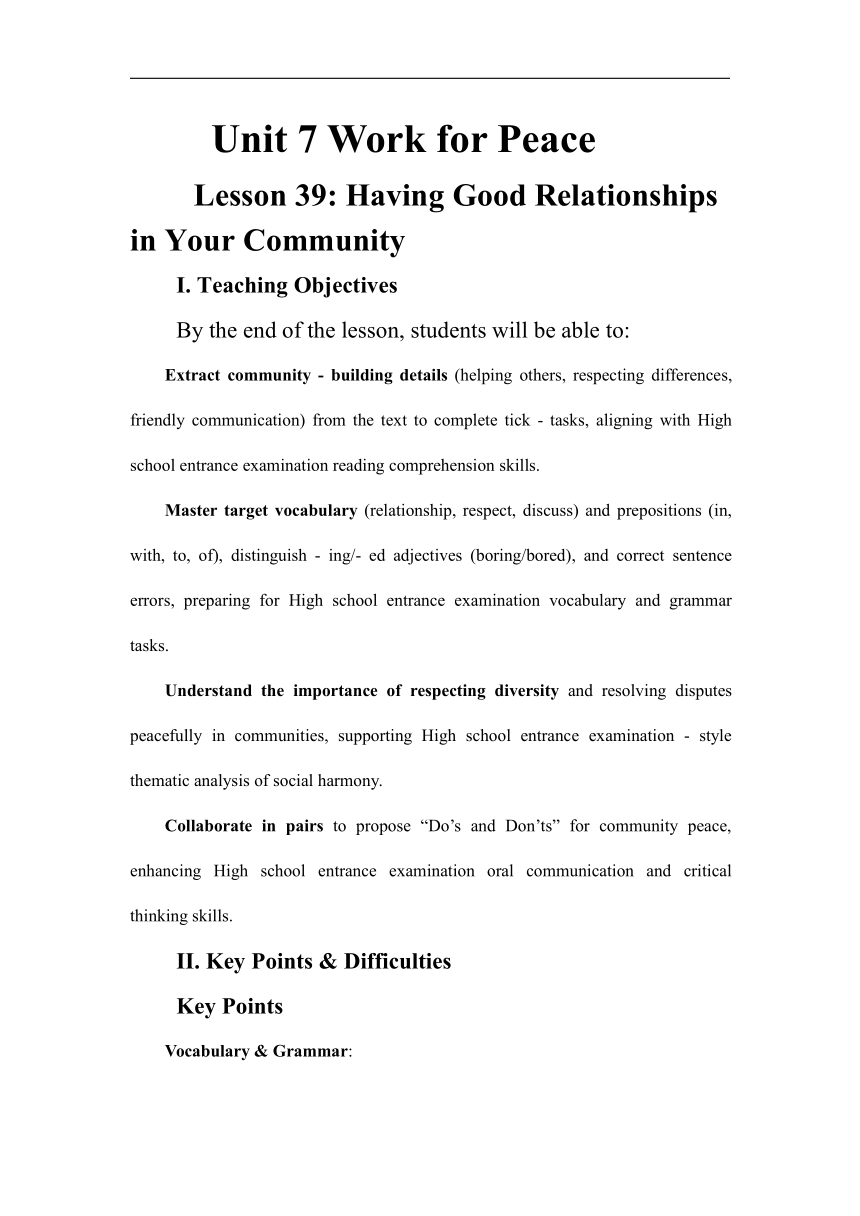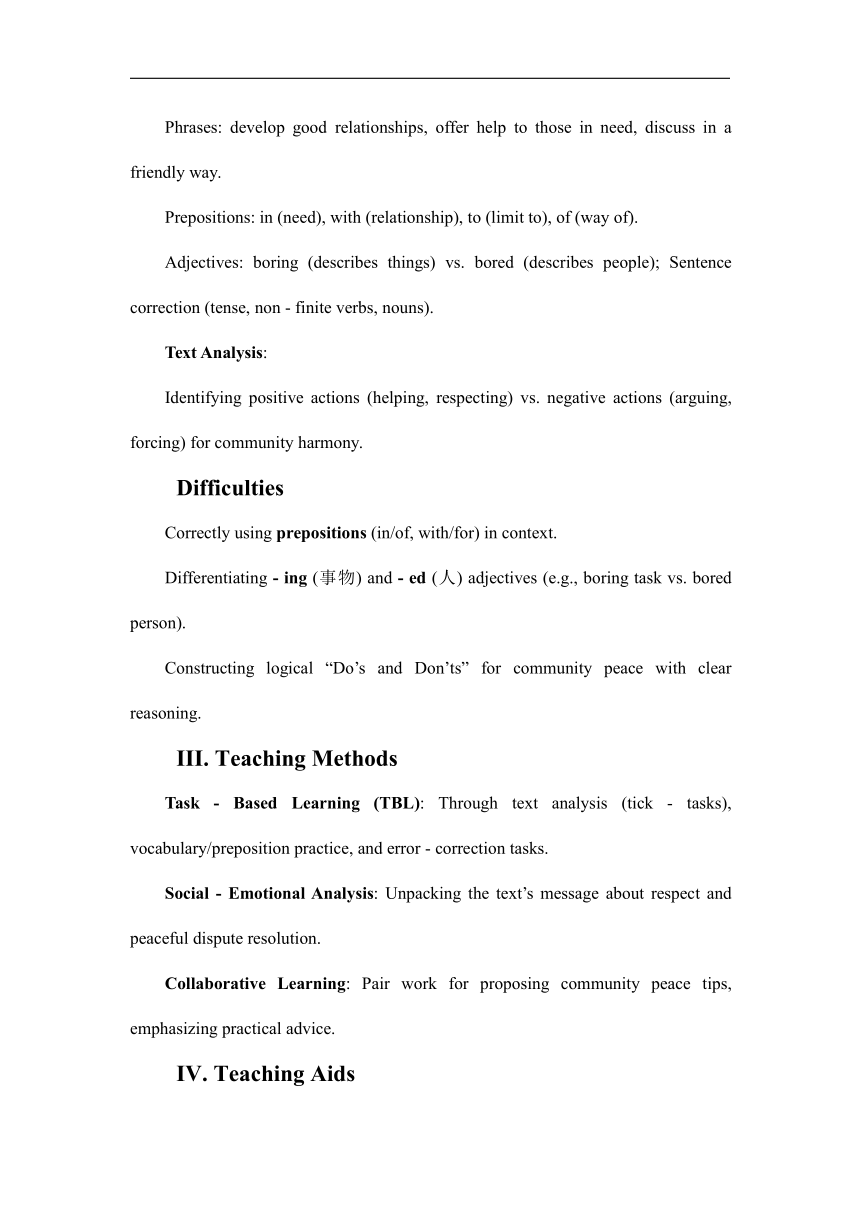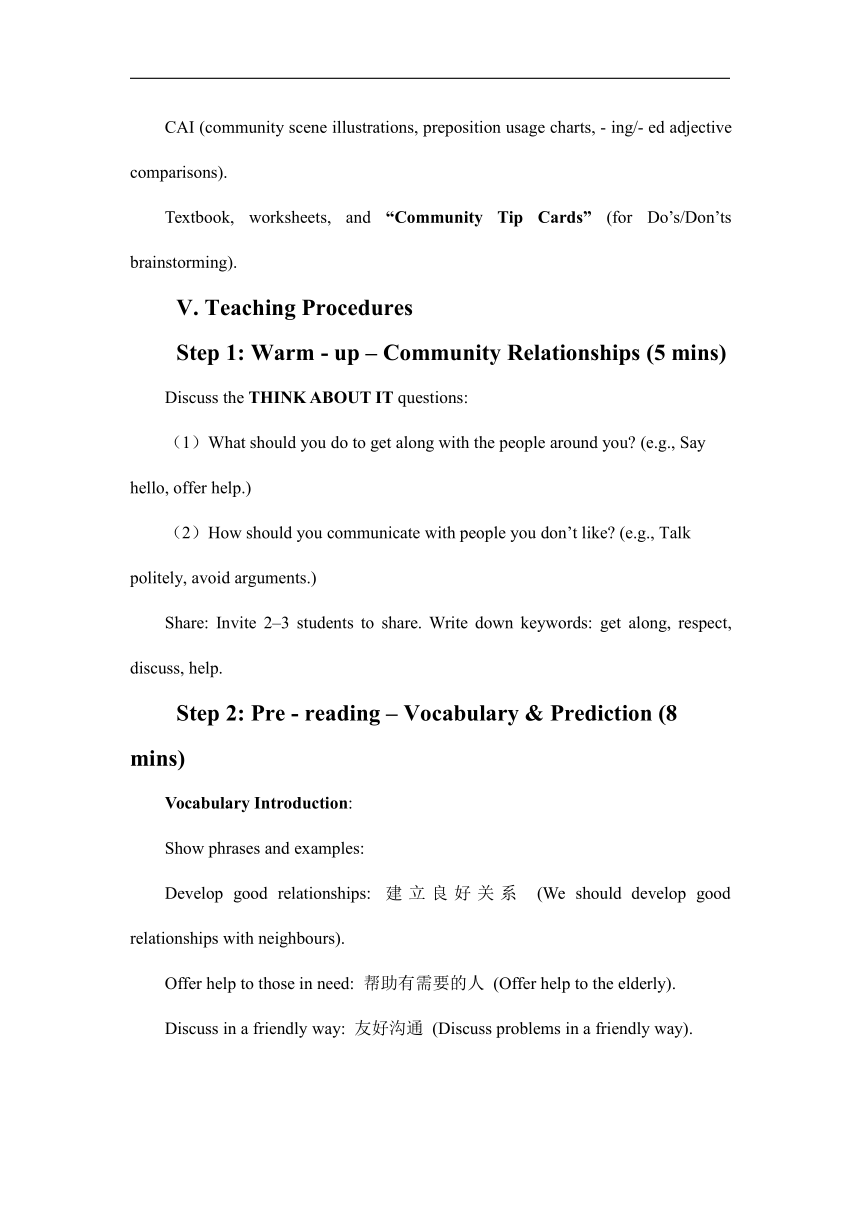Unit 7 Work for Peace Lesson 39 英文教学设计 冀教版英语九年级全册
文档属性
| 名称 | Unit 7 Work for Peace Lesson 39 英文教学设计 冀教版英语九年级全册 |  | |
| 格式 | docx | ||
| 文件大小 | 25.6KB | ||
| 资源类型 | 教案 | ||
| 版本资源 | 冀教版 | ||
| 科目 | 英语 | ||
| 更新时间 | 2025-08-12 14:52:17 | ||
图片预览



文档简介
Unit 7 Work for Peace
Lesson 39: Having Good Relationships in Your Community
I. Teaching Objectives
By the end of the lesson, students will be able to:
Extract community - building details (helping others, respecting differences, friendly communication) from the text to complete tick - tasks, aligning with High school entrance examination reading comprehension skills.
Master target vocabulary (relationship, respect, discuss) and prepositions (in, with, to, of), distinguish - ing/- ed adjectives (boring/bored), and correct sentence errors, preparing for High school entrance examination vocabulary and grammar tasks.
Understand the importance of respecting diversity and resolving disputes peacefully in communities, supporting High school entrance examination - style thematic analysis of social harmony.
Collaborate in pairs to propose “Do’s and Don’ts” for community peace, enhancing High school entrance examination oral communication and critical thinking skills.
II. Key Points & Difficulties
Key Points
Vocabulary & Grammar:
Phrases: develop good relationships, offer help to those in need, discuss in a friendly way.
Prepositions: in (need), with (relationship), to (limit to), of (way of).
Adjectives: boring (describes things) vs. bored (describes people); Sentence correction (tense, non - finite verbs, nouns).
Text Analysis:
Identifying positive actions (helping, respecting) vs. negative actions (arguing, forcing) for community harmony.
Difficulties
Correctly using prepositions (in/of, with/for) in context.
Differentiating - ing (事物) and - ed (人) adjectives (e.g., boring task vs. bored person).
Constructing logical “Do’s and Don’ts” for community peace with clear reasoning.
III. Teaching Methods
Task - Based Learning (TBL): Through text analysis (tick - tasks), vocabulary/preposition practice, and error - correction tasks.
Social - Emotional Analysis: Unpacking the text’s message about respect and peaceful dispute resolution.
Collaborative Learning: Pair work for proposing community peace tips, emphasizing practical advice.
IV. Teaching Aids
CAI (community scene illustrations, preposition usage charts, - ing/- ed adjective comparisons).
Textbook, worksheets, and “Community Tip Cards” (for Do’s/Don’ts brainstorming).
V. Teaching Procedures
Step 1: Warm - up – Community Relationships (5 mins)
Discuss the THINK ABOUT IT questions:
(1)What should you do to get along with the people around you (e.g., Say hello, offer help.)
(2)How should you communicate with people you don’t like (e.g., Talk politely, avoid arguments.)
Share: Invite 2–3 students to share. Write down keywords: get along, respect, discuss, help.
Step 2: Pre - reading – Vocabulary & Prediction (8 mins)
Vocabulary Introduction:
Show phrases and examples:
Develop good relationships: 建立良好关系 (We should develop good relationships with neighbours).
Offer help to those in need: 帮助有需要的人 (Offer help to the elderly).
Discuss in a friendly way: 友好沟通 (Discuss problems in a friendly way).
Prepositions: in need (有需要的), relationship with (和… 的关系), limit to (限制到), way of (… 的方式).
Prediction:
Ask: What actions help build good community relationships What should we avoid
Step 3: Reading – Positive vs. Negative Actions (12 mins)
Complete Let’s Do It! 1:
Tick the correct actions:
Offer help to those in need
Respect your neighbours and be kind to them
If neighbours have different ways, tell them they’re wrong (negative)
If neighbours upset you, discuss in a friendly way
If neighbours play loud music, force them to turn it off (negative)
Text Analysis:
Highlight key ideas:
Diversity is normal: People have different ways of living—no right or wrong.
Peaceful resolution: Discuss problems politely, avoid arguments.
Step 4: Vocabulary & Grammar Practice (10 mins)
Preposition Fill - in (Let’s Do It! 2):
Answers:
in (help those in need)
with (relationship with you)
to (limit to 20 minutes)
in (solved in a friendly way)
of (way of learning)
Error Correction (Let’s Do It! 3):
Corrections:
bored → boring (task is a thing, use - ing).
do → doing (without + gerund).
staying → to stay (allow sb. to do sth.).
lock → locked (past tense, parallel with put).
time → times (there are + plural noun).
Rule Summary:
- ing adjectives describe things; - ed adjectives describe people.
Allow + to - infinitive; Without + gerund.
Step 5: Speaking – Community Peace Tips (15 mins)
Task Introduction:
Prompt: “List 3–5 Do’s and Don’ts for a peaceful community.”
Provide sentence frames:
“We should ______ to build good relationships.”
“We shouldn’t ______ because it harms harmony.”
Pair Discussion:
Students brainstorm tips (e.g., Do greet neighbours; Don’t ignore problems), using text - based ideas.
Share & Feedback:
Pairs share tips. Class evaluates:
Clarity of advice, vocabulary accuracy (respect, discuss), and logical reasoning.
Step 6: Summary & Homework (5 mins)
Summary:
Recap community - building actions (help, respect, friendly talk), preposition rules, and - ing/- ed adjectives.
Homework:
(1)Write a 6 - sentence passage: “My Community Peace Tips” (include 2 Do’s and 2 Don’ts).
(2)Interview a neighbour about “How they resolve disputes” and summarize in 3 sentences.
VI. Blackboard Design
Vocabulary & Prepositions:
develop good relationships, offer help to..., discuss in..., relationship with...; Prepositions: in, with, to, of
Error Correction Rules:
Error Type Correction Example
- ing/- ed boring (task) vs. bored (person)
Allow allow to stay (not staying)
Gerund after without without doing (not do)
Tense locked (past tense)
Plural nouns times (not time)
Community Peace Tips:
Do: Help, Respect, Discuss; Don’t: Argue, Force, Ignore
Lesson 39: Having Good Relationships in Your Community
I. Teaching Objectives
By the end of the lesson, students will be able to:
Extract community - building details (helping others, respecting differences, friendly communication) from the text to complete tick - tasks, aligning with High school entrance examination reading comprehension skills.
Master target vocabulary (relationship, respect, discuss) and prepositions (in, with, to, of), distinguish - ing/- ed adjectives (boring/bored), and correct sentence errors, preparing for High school entrance examination vocabulary and grammar tasks.
Understand the importance of respecting diversity and resolving disputes peacefully in communities, supporting High school entrance examination - style thematic analysis of social harmony.
Collaborate in pairs to propose “Do’s and Don’ts” for community peace, enhancing High school entrance examination oral communication and critical thinking skills.
II. Key Points & Difficulties
Key Points
Vocabulary & Grammar:
Phrases: develop good relationships, offer help to those in need, discuss in a friendly way.
Prepositions: in (need), with (relationship), to (limit to), of (way of).
Adjectives: boring (describes things) vs. bored (describes people); Sentence correction (tense, non - finite verbs, nouns).
Text Analysis:
Identifying positive actions (helping, respecting) vs. negative actions (arguing, forcing) for community harmony.
Difficulties
Correctly using prepositions (in/of, with/for) in context.
Differentiating - ing (事物) and - ed (人) adjectives (e.g., boring task vs. bored person).
Constructing logical “Do’s and Don’ts” for community peace with clear reasoning.
III. Teaching Methods
Task - Based Learning (TBL): Through text analysis (tick - tasks), vocabulary/preposition practice, and error - correction tasks.
Social - Emotional Analysis: Unpacking the text’s message about respect and peaceful dispute resolution.
Collaborative Learning: Pair work for proposing community peace tips, emphasizing practical advice.
IV. Teaching Aids
CAI (community scene illustrations, preposition usage charts, - ing/- ed adjective comparisons).
Textbook, worksheets, and “Community Tip Cards” (for Do’s/Don’ts brainstorming).
V. Teaching Procedures
Step 1: Warm - up – Community Relationships (5 mins)
Discuss the THINK ABOUT IT questions:
(1)What should you do to get along with the people around you (e.g., Say hello, offer help.)
(2)How should you communicate with people you don’t like (e.g., Talk politely, avoid arguments.)
Share: Invite 2–3 students to share. Write down keywords: get along, respect, discuss, help.
Step 2: Pre - reading – Vocabulary & Prediction (8 mins)
Vocabulary Introduction:
Show phrases and examples:
Develop good relationships: 建立良好关系 (We should develop good relationships with neighbours).
Offer help to those in need: 帮助有需要的人 (Offer help to the elderly).
Discuss in a friendly way: 友好沟通 (Discuss problems in a friendly way).
Prepositions: in need (有需要的), relationship with (和… 的关系), limit to (限制到), way of (… 的方式).
Prediction:
Ask: What actions help build good community relationships What should we avoid
Step 3: Reading – Positive vs. Negative Actions (12 mins)
Complete Let’s Do It! 1:
Tick the correct actions:
Offer help to those in need
Respect your neighbours and be kind to them
If neighbours have different ways, tell them they’re wrong (negative)
If neighbours upset you, discuss in a friendly way
If neighbours play loud music, force them to turn it off (negative)
Text Analysis:
Highlight key ideas:
Diversity is normal: People have different ways of living—no right or wrong.
Peaceful resolution: Discuss problems politely, avoid arguments.
Step 4: Vocabulary & Grammar Practice (10 mins)
Preposition Fill - in (Let’s Do It! 2):
Answers:
in (help those in need)
with (relationship with you)
to (limit to 20 minutes)
in (solved in a friendly way)
of (way of learning)
Error Correction (Let’s Do It! 3):
Corrections:
bored → boring (task is a thing, use - ing).
do → doing (without + gerund).
staying → to stay (allow sb. to do sth.).
lock → locked (past tense, parallel with put).
time → times (there are + plural noun).
Rule Summary:
- ing adjectives describe things; - ed adjectives describe people.
Allow + to - infinitive; Without + gerund.
Step 5: Speaking – Community Peace Tips (15 mins)
Task Introduction:
Prompt: “List 3–5 Do’s and Don’ts for a peaceful community.”
Provide sentence frames:
“We should ______ to build good relationships.”
“We shouldn’t ______ because it harms harmony.”
Pair Discussion:
Students brainstorm tips (e.g., Do greet neighbours; Don’t ignore problems), using text - based ideas.
Share & Feedback:
Pairs share tips. Class evaluates:
Clarity of advice, vocabulary accuracy (respect, discuss), and logical reasoning.
Step 6: Summary & Homework (5 mins)
Summary:
Recap community - building actions (help, respect, friendly talk), preposition rules, and - ing/- ed adjectives.
Homework:
(1)Write a 6 - sentence passage: “My Community Peace Tips” (include 2 Do’s and 2 Don’ts).
(2)Interview a neighbour about “How they resolve disputes” and summarize in 3 sentences.
VI. Blackboard Design
Vocabulary & Prepositions:
develop good relationships, offer help to..., discuss in..., relationship with...; Prepositions: in, with, to, of
Error Correction Rules:
Error Type Correction Example
- ing/- ed boring (task) vs. bored (person)
Allow allow to stay (not staying)
Gerund after without without doing (not do)
Tense locked (past tense)
Plural nouns times (not time)
Community Peace Tips:
Do: Help, Respect, Discuss; Don’t: Argue, Force, Ignore
同课章节目录
- Unit 7 Work for Peace
- Lesson 37 Don't Fight!
- Lesson 38 Making School a Better Place
- Lesson 39 The Dove and the Olive Branch
- Lesson 40 The UN—Power of Words
- Lesson 41 Jenny's Good Advice
- Lesson 42 Peace at Last
- Unit Review
- Unit 8 Culture Shapes Us
- Lesson 43 A Visit to Chinatown
- Lesson 44 Popular Sayings
- Lesson 45 Different Manners
- Lesson 46 Home to Many Cultures
- Lesson 47 Good Manners
- Lesson 48 Supper with the Bradshaws
- Unit Review
- Unit 9 Communication
- Lesson 49 Get Along with Others
- Lesson 50 Tips for Good Communication
- Lesson 51 What Could Be Wrong?
- Lesson 52 The Power of a Smile
- Lesson 53 Working in Groups
- Lesson 54 How Embarrassing!
- Unit Review
- Unit 10 Get Ready for the Future
- Lesson 55 Look into the Future
- Lesson 56 Manage Your Time
- Lesson 57 Best Wishes
- Lesson 58 Ms.Liu's Speech
- Lesson 59 Keep Your Choices Open
- Lesson 60 Get a Good Education
- Unit Review
